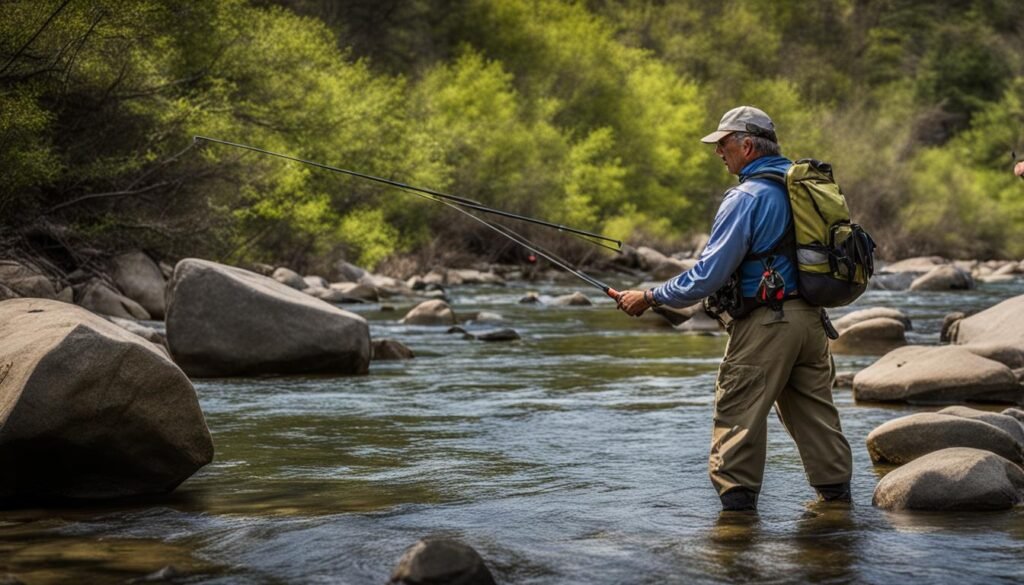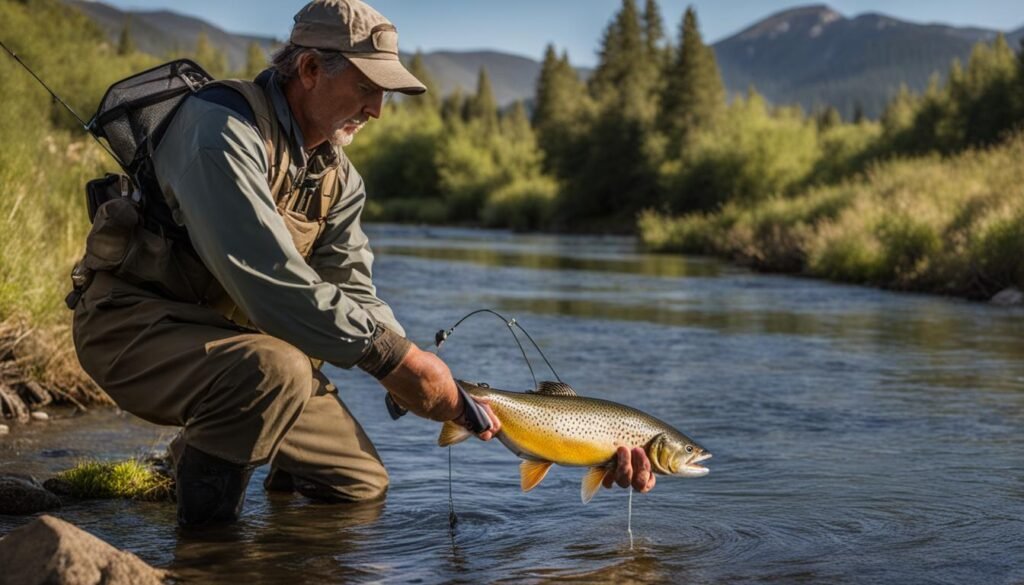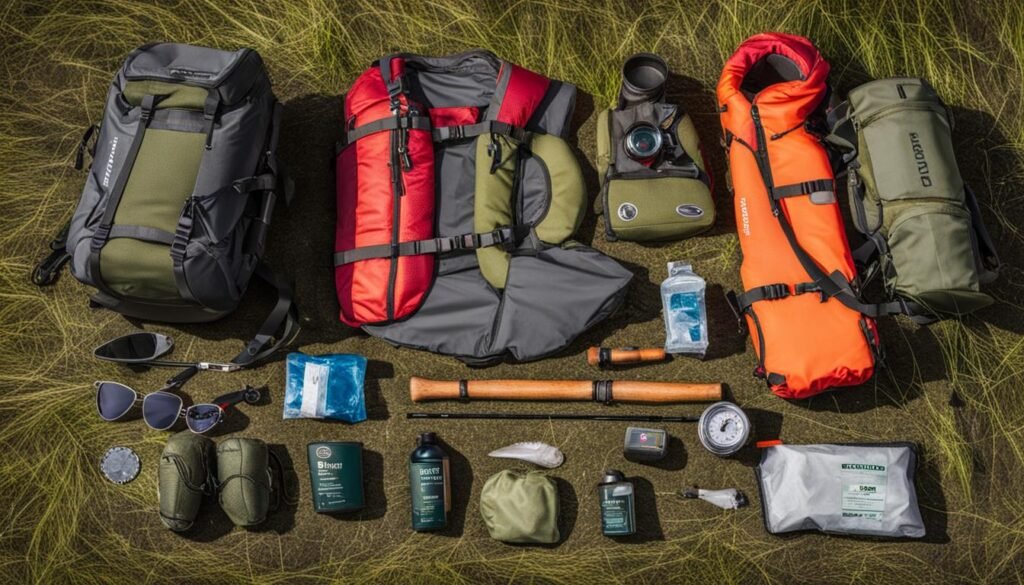No matter your experience in fishing, it’s crucial to prioritize safety to ensure a stress-free and enjoyable experience. In this section, we’ll provide you with essential fly fishing safety tips, guidelines, and gear recommendations to keep you safe on the water.
Prepare for the Weather
When it comes to fly fishing, being prepared for the weather is essential for a safe and enjoyable experience. Dressing in layers is key, allowing you to adjust your clothing as needed to regulate your body temperature. Start with a moisture-wicking base layer to keep your skin dry, then add insulating layers such as fleece or wool to trap warmth. Finally, top it off with a waterproof and windproof outer layer to protect against moisture and wind. Dressing in layers ensures that you can adapt to changing weather conditions and stay comfortable throughout your fishing trip.
Another important aspect of weather preparation is protecting yourself from the sun’s harmful rays. Even on cloudy days, UV rays can penetrate the clouds and cause damage to your skin. To protect yourself, wear a wide-brimmed hat to shade your face and neck, and apply a broad-spectrum sunscreen with at least SPF 30 to any exposed skin. Don’t forget to reapply sunscreen every two hours, or more frequently if you’re sweating or in and out of the water.
Lastly, always stay aware of the weather conditions while you’re out fly fishing. Lightning can be a serious danger, so if you see or hear a storm approaching, it’s important to get off the water and take shelter immediately. Avoid being the tallest object in an open area, and seek refuge in a vehicle or substantial building if possible. Remember, it’s better to be safe than sorry when it comes to lightning safety.
Lightning Safety Tips:
- Monitor weather forecasts and be alert for signs of approaching storms.
- Develop a plan for seeking shelter and designate a safe meeting place.
- If you’re caught in a storm, avoid open areas, bodies of water, and tall objects.
- Take shelter in a substantial building or a fully enclosed vehicle with windows closed.
- Wait at least 30 minutes after the last observed lightning or thunder before returning to the water.
| Weather Condition | Recommended Clothing |
|---|---|
| Hot and Sunny | Lightweight, breathable clothing, wide-brimmed hat, sunglasses, sunscreen |
| Cool and Breezy | Moisture-wicking base layer, insulating layers, windproof and waterproof outer layer |
| Rainy | Waterproof and breathable rain gear, waterproof footwear |
| Cloudy | Moisture-wicking clothing, light layers for temperature regulation |
By preparing for the weather and prioritizing your safety, you can fully enjoy the fly fishing experience while minimizing any potential risks or discomfort. Remember to dress in layers, protect yourself from the sun, and stay aware of changing weather conditions. With these tips in mind, you’ll be well-equipped to have a safe and successful fly fishing adventure.
Safely Navigate Potential Dangers in Fly Fishing
Fly fishing is an exhilarating sport that allows you to connect with nature and experience the thrill of the catch. However, it’s essential to be aware of potential dangers to ensure a safe and enjoyable fishing trip. By following these fly fishing safety tips, you can minimize risks and focus on the excitement of reeling in your next big catch.
Protect Your Eyes with Proper Eye Protection
One of the most critical safety measures in fly fishing is protecting your eyes. Always wear a pair of quality polarized sunglasses to shield your eyes from stray hooks and harmful UV rays. The polarized lenses will also reduce glare, allowing you to see more clearly into the water and spot fish with ease.
Be Vigilant of Tailwater Hazards
Tailwater hazards, which are created downstream from dams, can pose a significant risk to fly anglers. These hazards can cause water levels to rise rapidly and unexpectedly, putting you in a dangerous situation. Before heading out to fish, check local water release schedules and be aware of any possible changes in water conditions. Stay informed and avoid fishing in tailwater areas during unsafe times.
Prioritize Personal Safety with Proper Gear
When venturing out onto the water, remember to wear a life jacket or personal flotation device (PFD). Regardless of your swimming abilities, wearing a PFD can save your life in case of an accident or unexpected changes in weather conditions. Additionally, always inform someone you trust about your fishing location and expected return time. This precaution ensures that someone is aware of your whereabouts and can alert authorities if necessary.

| Fly Fishing Safety Tips | |
|---|---|
| 1. Wear proper eye protection, such as polarized sunglasses, to shield your eyes from hooks and UV rays. | |
| 2. Stay informed about tailwater hazards and avoid fishing in areas with rapidly rising water levels. | |
| 3. Always wear a life jacket or PFD when fishing on or near the water, and inform someone of your fishing location. |
Fly Fishing Safety: Ensuring the Well-being of Fish
As an angler, it’s important to prioritize the safety and well-being of the fish you catch. By practicing catch and release and handling fish properly, you can minimize stress and potential harm to the fish population. Here are some essential tips to ensure fish safety while fly fishing:
Proper Handling Techniques
When handling fish, wet your hands before touching them to avoid removing their protective slime layer, which helps to prevent disease and infection. Avoid brushing the fish against dry clothing, as it can remove scales and lead to injury. It’s crucial to be quick and efficient when removing the hook. Use a knotless or rubber net to land the fish and keep it in the water while removing the hook if possible. This reduces the risk of injury and stress to the fish.
Reviving Fish Before Release
Before releasing a fish, ensure that it has been properly revived and is capable of swimming away. Gently hold the fish in an upright position underwater, allowing water to flow through its gills. This helps to oxygenate the fish and restore its energy. Avoid forcefully releasing the fish or tossing it back into the water. Instead, gently release it from your grasp and allow it to swim away at its own pace.
Importance of Catch and Release
Catch and release is a fundamental practice in fly fishing that helps to conserve fish populations. By releasing fish back into the water, you contribute to the sustainability of the ecosystem and ensure that future generations can enjoy the sport as well. Remember to handle fish with care, use proper techniques, and minimize their time out of the water to increase their chances of survival.

Fly Fishing Safety Tips for Fish Handling:
- Wet your hands before handling fish
- Avoid brushing fish against dry clothing
- Use a knotless or rubber net
- Keep the fish in the water while removing the hook
- Hold the fish upright underwater to revive it
- Release the fish gently and allow it to swim away
Practice Wading and Watercraft Safety
When it comes to fly fishing safety, wading and watercraft precautions are essential. By practicing proper wading technique, you can minimize the risk of accidents and ensure a safe experience. Remember to cross rivers at an upstream angle, which helps maintain stability and control. Always be mindful of your footing and look out for any potential hazards in the water.
A useful tool to consider for wading safety is a wading staff. This accessory provides extra stability and traction on slippery surfaces. With a wading staff, you can confidently navigate through various river conditions and maintain your balance.
Another crucial aspect of water safety is utilizing polarized sunglasses. These sunglasses not only protect your eyes from harmful UV rays but also allow you to see the bottom of the river with enhanced clarity. By being able to spot hazards such as rocks or submerged logs, you can avoid potential accidents and injuries.
When using any watercraft, whether it be a kayak or a boat, it is vital to prioritize watercraft safety. Always wear a life jacket to ensure personal flotation in case of an emergency, even if you are a skilled swimmer. Stay vigilant and aware of your surroundings, being mindful of potential hazards such as strong currents or submerged objects. By following these safety measures, you can enjoy your fly fishing adventure while minimizing risks and ensuring your well-being.

